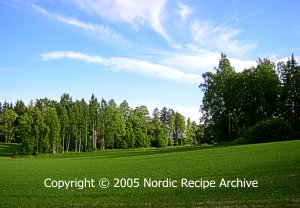 At midsummer, the people in the Nordic countries celebrate the lightest time of the year and the proper start of summer season. The short winter days are far behind and one can enjoy the long days and white nights of Nordic summer.
At midsummer, the people in the Nordic countries celebrate the lightest time of the year and the proper start of summer season. The short winter days are far behind and one can enjoy the long days and white nights of Nordic summer.
Although an ancient feast, midsummer is still an important national festival in Finland, as well as in Sweden and Norway.
Midsummer is celebrated on June 24th, but in Finland (in year 1955) and Sweden (in year 1953), the date was moved to fall on the first Saturday after June 19th, on the initiative of labour organizations.

In picture above: Helsinki skyline from the sea at midnight around the summer solstice.
The major midsummer festivities in Finland and Sweden take place on Midsummer Eve, the Friday preceding the Midsummer Day. Like Christmas Eve, the Midsummer Eve is a public holiday, during which only stores are open part of the day.
Midnight sun
 Midsummer is also the time of summer solstice, the culmination of summer and a turning point after which the days begin to slowly shorten again in the northern hemisphere. The day of summer solstice falls between the 20th and 22nd of June.
Midsummer is also the time of summer solstice, the culmination of summer and a turning point after which the days begin to slowly shorten again in the northern hemisphere. The day of summer solstice falls between the 20th and 22nd of June.
During the period called polar days, the nights are short and light, while in the regions north of the arctic circle the sun does not set below the horizon at all for several weeks.
In the village of Nuorgam, situated near the northernmost point of Finland, the sun does not set between the mid-May and the end of July.
Note: on the longest day of the year, the sun in Helsinki, southern Finland rises at 03:54 and sets at 22:50 [GMT + 3:00 (Eastern European Daylight/Summer Time)].
| Summer solstice dates (GMT) |
| Year |
2013 |
2014 |
2015 |
2016 |
2017 |
2018 |
2019 |
| Date |
June 21st |
June 21st |
June 21st |
June 20th |
June 21st |
June 21st |
June 21st |
| |
| Midsummer dates in Finland and Sweden |
| Year |
2013 |
2014 |
2015 |
2016 |
2017 |
2018 |
2019 |
| Date |
June 22nd |
June 21st |
June 20th |
June 25th |
June 24th |
June 23rd |
June 22nd |
Pagan feast and the name day of St. John the Baptist
 At midsummer, after the spring sowing, the ancient Finns celebrated the feast of Ukko, the pagan Finnish god of weather, fertility, and growth.
At midsummer, after the spring sowing, the ancient Finns celebrated the feast of Ukko, the pagan Finnish god of weather, fertility, and growth.
Midsummer was celebrated as a feast of fertility until the Christian era, during which the 24th of June was fixed to commemorate the birth of John the Baptist, the saint who baptized Jesus.
In picture on right: a detail from "The Birth of John the Baptist" by Tintoretto (1550s).
Although the Christian church has celebrated June 24th as the birthday of John the Baptist since the 5th century, the day is not a major festival in the Finnish Evangelical-Lutheran Church.
The modern Finnish midsummer celebration is a mixture of pagan and Christian traditions. It is celebrated on the Saturday falling between June 20th and 26th.
Finnish summer holiday season
 The receding winter gives way to Finnish summer and a more relaxed way of life.
The receding winter gives way to Finnish summer and a more relaxed way of life.
At midsummer, many people start their summer holiday, normally lasting for four weeks.
(Here in Finland, all employees, after their first year of work, get a minimum of 30 statutory paid
vacation days, Sundays excluded, plus up to fourteen paid public holidays a year. Jealous? :-)
The weather permitting, some Finns like to spend the brief summer enjoying the outdoors. They head to their summer cottages, go swimming, boating or sailing or attend the numerous art and music festivals or other cultural events held throughout the country.
Since warm and sunny summer weather is not always guaranteed in Finland, some Finns like to spend part of their holidays travelling abroad.
 Many Finns like to spend the midsummer in the countryside. People head for their cottages and summer cabins, leaving towns and cities deserted.
Many Finns like to spend the midsummer in the countryside. People head for their cottages and summer cabins, leaving towns and cities deserted.
Most people living in Helsinki, the Finnish capital, are originally from countryside, or at least their parents have a rural background. In summertime, these "yokels" mostly return to their home counties and parental homes, leaving a tiny minority of us urbanites to enjoy the peace and quiet of the capital city, which turns almost into a ghost town.

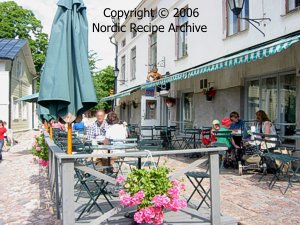
 A summer cottage with a lakeside sauna is a summer dream for most Finns. They long to escape the busy city life to spend their holiday quietly in the bosom of Mother Nature, chopping firewood, fetching water from a lake or a well, bathing in sauna and eating barbecued food for days on end.
A summer cottage with a lakeside sauna is a summer dream for most Finns. They long to escape the busy city life to spend their holiday quietly in the bosom of Mother Nature, chopping firewood, fetching water from a lake or a well, bathing in sauna and eating barbecued food for days on end.
According to one study, only 7 % of Finns (myself included!) have no desire whatsoever for a countryside vacation.
MIDSUMMER TRADITIONS
 Midsummer is a popular day for church confirmations and summer weddings in Finland. Many commercial midsummer festivals are organized around the country, consisting of good eating and (usually too heavy) drinking, dancing, singing
and burning of bonfires.
Midsummer is a popular day for church confirmations and summer weddings in Finland. Many commercial midsummer festivals are organized around the country, consisting of good eating and (usually too heavy) drinking, dancing, singing
and burning of bonfires.
In picture on right: Finnish youngsters attending a church confirmation.
Midsummer bonfire
Burning bonfires to celebrate a great feast is an old tradition that has been practised in many countries. In the old times, bonfires were burnt to dispel evil spirits and bad fortune or to enhance light and warmth and the fertility of domestic animals, crops and people.
In modern day Finland, bonfires are mainly burnt in midsummer, although in some regions they are also burnt on Easter Saturday.
 Formerly, large bonfires were built on hills and lakeshores in every village of eastern Finland. Besides tree branches and twigs, the largest bonfires consisted of whole old rowing boats, wooden barrels and other used-up tools or farming equipment.
Everyone in the village gathered to watch the bonfire burn and to dance, sing and play games together. This custom spread throughout Finland and is still practised here today.
Formerly, large bonfires were built on hills and lakeshores in every village of eastern Finland. Besides tree branches and twigs, the largest bonfires consisted of whole old rowing boats, wooden barrels and other used-up tools or farming equipment.
Everyone in the village gathered to watch the bonfire burn and to dance, sing and play games together. This custom spread throughout Finland and is still practised here today.
A traditional midsummer bonfire event is held every year at the open-air museum of Seurasaari, located in Helsinki. The museum consists of historical rural buildings, cottages and farmsteads collected around Finland. The highlight of the event, including a genuine midsummer wedding, is the lighting of a huge bonfire, one of which is shown in the picture above left.

Midsummer pole
 In Sweden, and in some Swedish-speaking regions of Finland, tall midsummer poles are erected on Midsummer Eve, similar to the maypoles raised in the continental Europe and Britain.
The pole is decorated with green leaves, garlands, wreaths and flowers before raising. During the evening, traditional folk music is played with people dancing and playing around the pole. Some people may wear national costumes to highlight the celebration.
In Sweden, and in some Swedish-speaking regions of Finland, tall midsummer poles are erected on Midsummer Eve, similar to the maypoles raised in the continental Europe and Britain.
The pole is decorated with green leaves, garlands, wreaths and flowers before raising. During the evening, traditional folk music is played with people dancing and playing around the pole. Some people may wear national costumes to highlight the celebration.
In some parts of western Finland, it was a tradition to raise a tall and narrow spruce tree instead of a decorated midsummer pole. The spruce was stripped of its lower branches and only the top few branches were left in place. Like the midsummer poles, the spruce was
left to stand on the yard until the next midsummer. The midsummer pole may be seen as a phallic symbol of ancient pagan fertility rites.
Midsummer decorations
 The effect of early summer's fresh verdancy is seen in the decorations used in Finnish midsummer celebration. An old tradition is to decorate the house and yard with young leafy trees like birch or aspen.
The cut trees were placed standing at either side of doorways, gates or doorsteps, and windows were bordered with leafy branches.
The effect of early summer's fresh verdancy is seen in the decorations used in Finnish midsummer celebration. An old tradition is to decorate the house and yard with young leafy trees like birch or aspen.
The cut trees were placed standing at either side of doorways, gates or doorsteps, and windows were bordered with leafy branches.
Scented flowers, like lilies of the valley, or blossoming branches of mountain ash, bird cherry and lilac are brought in and placed in vases.
These customs are still practised in countryside and on summer cottages during midsummer celebration.
 In some parts of Finland, it was a custom for young men to build arbours on farm yards, using leafy branches of birch. Even cows were decorated with green leaves or lilies of the valley to ensure they would be milking properly.
In some parts of Finland, it was a custom for young men to build arbours on farm yards, using leafy branches of birch. Even cows were decorated with green leaves or lilies of the valley to ensure they would be milking properly.
Fresh birch twigs are also gathered to tie up special switches that are then used to slap oneself while bathing in Finnish sauna.
In picture on right: a Finnish birch switch in sauna.
Midsummer night magic
 Many magical and supernatural aspects have traditionally been linked to midsummer night, the shortest night of the year, giving cause to various religious and superstitious beliefs.
Many magical and supernatural aspects have traditionally been linked to midsummer night, the shortest night of the year, giving cause to various religious and superstitious beliefs.
Although being a feast of light, new life and nature in its prime, midsummer is also the turning point at which the days begin to shorten again, and darkness will slowly start increasing.
In the old times, this raised fear and uncertainty about the future.
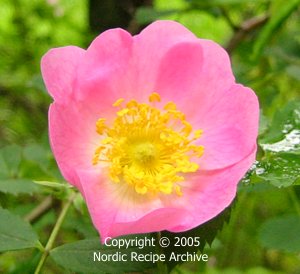 Strange things were known to happen on midsummer night, when evil spirits and witches were thought to be roaming around.
Strange things were known to happen on midsummer night, when evil spirits and witches were thought to be roaming around.
By performing magical rites people believed they could secure a better future for themselves, to ensure a good fortune for the household, an abundant crop and protect the livestock from illnesses.
Many of these rites were connected with fortune, happiness, love, marriage and relationships or predicting of the future.
 Various herbs and medicinal plants picked on midsummer night, before the morning dew had fallen, were thought to be at the peak of their power. The dew formed on midsummer night was believed to have healing powers.
Various herbs and medicinal plants picked on midsummer night, before the morning dew had fallen, were thought to be at the peak of their power. The dew formed on midsummer night was believed to have healing powers.
Cattle could be protected by hanging mountain ash branches from the ceiling of the stall and their illnesses cured by feeding the animals hay that had been mown on Midsummer Eve.
Dreams could be made come true by sleeping through midsummer night with nine different flowers placed under the pillow. According to some beliefs, the flowers had to be picked in the lands of three different farmsteads, without uttering a word.
 One could see in the future by sitting on the rooftop of a house that had been thrice moved from its premises, or by sitting under an old apple tree on midsummer night.
One could even see the devil himself if one would strip oneself naked and run thrice around a rye field.
One could see in the future by sitting on the rooftop of a house that had been thrice moved from its premises, or by sitting under an old apple tree on midsummer night.
One could even see the devil himself if one would strip oneself naked and run thrice around a rye field.
On midsummer night, one could catch a treasure by keeping an eye on will-o'-the-wisps, the phosphorescent lights that can sometimes be seen flickering over marshlands. The light would reveal a spot on which a treasure has been buried.
There are various magical tasks and tricks for young girls (and boys) to perform on Midsummer Eve in order to know whether they would soon be married or to get a glimpse of their future spouse:

- A girl picks seven or nine different species of wild flowers and places them under her pillow for the night. While sleeping, the face or the name of her future husband will be revealed for her in a dream.
- If a girl picks the nine flowers in nine different meadows, she will meet her future husband on Midsummer Eve.
- A girl eats salty food, usually salted fish, before going to bed. In her sleep she gets thirsty, and he who brings her water in her dream will be her future husband.
- If a girl rolls around naked on a dewy field, she is sure to meet her fiancé during the passing year.
- If a girl goes to stand at crossroads on midsummer night, she will meet her future husband.
- A girl goes up to a well on midsummer night, and listens carefully. If she hears a clinking of keys, it means she is to become a mistress of a house. If she hears a crying of a baby, it means she is to have a child.
- If a girl goes up to a well or a spring naked on midsummer night, she will see the face of her future husband briefly reflected in the water.
- A girl makes a wreath of fresh flowers and drops it in a flowing stream. If the current carries the wreath away, it means wedding for the girl, but if the wreath is caught somewhere along the way, it means death for her.
And the list goes on...
FINNISH SUMMER DELICACIES
Vegetables, fruits and berries
 Midsummer opens the season for the arrival of locally grown fresh Finnish vegetables, fruits and berries, sold in abundance at market squares of cities and small towns or in various farm stores.
Midsummer opens the season for the arrival of locally grown fresh Finnish vegetables, fruits and berries, sold in abundance at market squares of cities and small towns or in various farm stores.
New potatoes, juicy tomatoes, garden cucumbers, cauliflowers, radishes, crisp new cabbages and lettuce, sweet green peas and carrots, leafy green onions and fresh, fragrant dill are an essential part of Finnish summer.
Either eaten fresh, briefly cooked or added to salads and stews, vegetables are served to accompany many summertime meat and fish dishes.

In picture above: the central Market Square in Helsinki.


In picture above: vegetable stalls at the Market Square in Helsinki.
Most Finnish wild berries do not start to ripen until early July, but many cultivated varieties are available already during the spring.
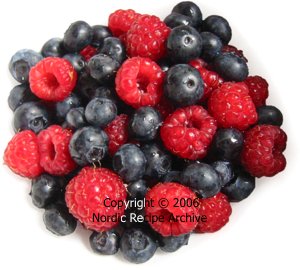 Even though nowadays most fruits and berries are available year round, they cannot be compared with the ones grown and ripened in the long summer days of Finland and other Nordic countries.
Even though nowadays most fruits and berries are available year round, they cannot be compared with the ones grown and ripened in the long summer days of Finland and other Nordic countries.
Eagerly awaited, these fruits and berries are much more aromatic and flavourful than the ones imported from abroad outside the growing season.
In the late summer and early autumn, Finnish forests and bogs are abundant with juicy and aromatic bilberries, lingonberries, cranberries and cloudberries, just to mention a few varieties.
Finnish berries are eaten fresh, perhaps accompanied by a dash of sugar and milk, cream or ice cream. They are also baked in pies and made into juices, jams and jellies.
Fresh strawberry and whipped cream layer cake is a traditional summertime treat in Finland.
Read more about various Finnish berries here.
 However, like in most Western countries with no respect for good cuisine, the old tasty varieties of fruits and berries are constantly being replaced with newer ones that withstand handling, transportation, storing and freezing better, but lack all the good old-fashioned flavour.
However, like in most Western countries with no respect for good cuisine, the old tasty varieties of fruits and berries are constantly being replaced with newer ones that withstand handling, transportation, storing and freezing better, but lack all the good old-fashioned flavour.
This is especially true regarding many modern varieties of Finnish strawberries and tomatoes — the former are often hard and bland, the latter watery and absolutely tasteless, containing hardly any flesh at all.
Regardless of this fact, most Finns stubbornly insist our brands of overpriced bland tomatoes and raw potato-like strawberries to be "the best in the world".
Of course, it is impossible to recognise truly tasty vegetables and berries, if one has never had the chance to taste any, as is true with most Finns, unfortunately :-)
Fresh milk and cheese
 In the pre-20th century Finland, cows produced milk in the spring and summer only, and it was a tradition to start preparing cheese and other fresh or fermented dairy products as soon as fresh milk became available.
This is why many traditional dairy products were made in midsummer.
In the pre-20th century Finland, cows produced milk in the spring and summer only, and it was a tradition to start preparing cheese and other fresh or fermented dairy products as soon as fresh milk became available.
This is why many traditional dairy products were made in midsummer.
In picture on right: "viili" — fresh homemade Finnish curd milk.
Various types of fresh cheeses and cheese making recipes were known in different parts of Finland. Besides cheese, fresh milk was also processed into fermented milk,
quark, curd milk and longmilk, among other dairy products. Also dishes rich in milk were made — milk gruels and porridges, crêpes, pancakes and various pastries.
 Fresh cheeses were made, and still are, by curdling milk with buttermilk or rennet. The resulting curds may be enriched with mixing in eggs, cream and various spices and herbs.
Fresh cheeses were made, and still are, by curdling milk with buttermilk or rennet. The resulting curds may be enriched with mixing in eggs, cream and various spices and herbs.
The curds are pressed into a block or disk of cheese, which is either eaten fresh or baked in oven or broiled briefly over open fire.
In picture on left: fresh cheese pressed using a traditional cheese mould.
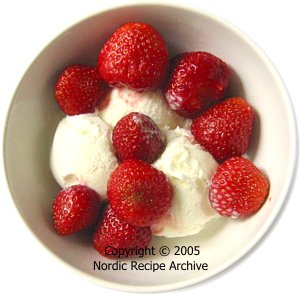 In some regions, it was a custom to prepare one fresh cheese for each young girl and maid of the household. The cheeses were handed out to young men who went from house to house asking for them, and in return brought young, leafy birches which were placed to decorate the doorways.
In some regions, it was a custom to prepare one fresh cheese for each young girl and maid of the household. The cheeses were handed out to young men who went from house to house asking for them, and in return brought young, leafy birches which were placed to decorate the doorways.
Cut birches are still often used as decoration in Midsummer, mainly in Finnish summer cottages and other country residences.
In picture on right: strawberries with ice cream is a popular simple summer dessert in the Nordic countries.
Fish and meat
 Fresh fish is a favourite summer food for Finns. Species abundant at summertime are salmon, rainbow trout, trout, Baltic herring, pike-perch, bream and powan, among others.
Fresh fish is a favourite summer food for Finns. Species abundant at summertime are salmon, rainbow trout, trout, Baltic herring, pike-perch, bream and powan, among others.
Fish is most often eaten fried, barbecued, poached, smoked and freshly salted or used to prepare soups and added to salads. Pickled and marinated herring is always eaten with boiled new potatoes and fresh dill (see the picture on right).
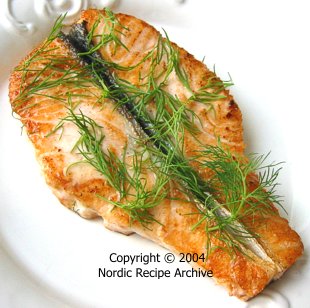 Barbecuing outdoors is a quick and popular cooking method in summertime, especially among Finns residing in their summer cottages.
Barbecuing outdoors is a quick and popular cooking method in summertime, especially among Finns residing in their summer cottages.
In picture on right: barbecued salmon.
Besides fish and vegetables, various meats, like pork, beef, lamb and poultry, are barbecued. Cuts of meat, like kassler pork, are usually marinated before barbecuing.
A sure summer favourite is barbecued sausage, eaten with sweet Finnish mustard.
You will find recipes for some of the dishes mentioned above in here.
